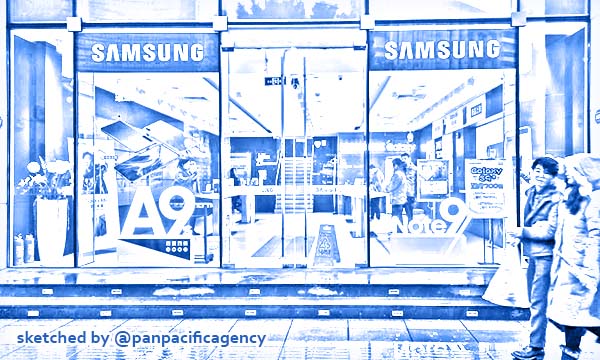Samsung shares could rise 50 per cent as chip business gets a boost and Huawei struggles in smartphones

Korean exports down: Pedestrians walk past a Samsung store in Shanghai. Photo: AFP. Sketched by the Pan Pacific Agency.
SEOUL, Sep 2, 2020, CNBC. Analysts are bullish on Samsung after the company unveiled a foldable phone on Tuesday and U.S. semiconductor company Nvidia said its next-generation gaming chip will be manufactured by the South Korean electronics giant, CNBC reported.
They see Samsung’s shares trading at 70,376.32 Korean won ($59.35) in the next 12 months. That represents a 29% upside from Wednesday’s trading price, according to an average target price collated by Refinitiv.
Some analysts are even more bullish on Samsung. Daiwa Capital Markets’ SK Kim has a 12-month price target of 82,000 Korean won, a more than 50% rise from Wednesday’s trading price.
New orders for Samsung’s chip manufacturing operations or foundry, next-generation smartphone launches and a recovery in memory pricing next year are factors behind the analysts’ optimism.
“For SEC (Samsung Electronics), we maintain our positive view as we expect a favourable memory market environment in 2021, new foundry opportunities and attractive valuation compared with its peers such as TSMC,” Kim told CNBC in an email.
On Tuesday, Nvidia launched the GeForce RTX 30 Series of graphics processing units (GPUs). The chips are designed for PC gaming and promise to offer more realistic images on screen, thanks to so-called “ray tracing.” This technology simulates how light reacts with objects around it.
Nvidia chose Samsung to manufacture the chips using a so-called 8 nanometer process customized for these semiconductors.
The move was seen as positive for Samsung. Daiwa’s Kim told CNBC he expects the Nvidia deal to be worth $1 billion in revenue for Samsung.
Samsung’s semiconductor business is very important for the company. It includes the foundry business as well as the sales of so-called NAND and DRAM chips Samsung produces, which are used in devices such as laptops and smartphones, through to data centers. Semiconductors accounted for two-thirds of Samsung’s operating profit in the second quarter of this year.
DRAM pricing, which has been under pressure in the second quarter, is expected to face further weakness for the rest of the year, according to a note released by UBS last week. The investment bank sees DRAM prices falling 8% quarter-on-quarter in the third quarter of this year.
But the start of 2021 could bring a recovery.
“First, we continue to expect DRAM pricing to start to recover in 1H21 as industry supply growth will not match demand when smartphones demand is closer to normalized levels,” UBS said, referring to the first half of next year.
On Tuesday, Samsung announced the Galaxy Z Fold 2 — the company’s third folding phone. The device launches on Sept. 18 for $1,999.
While foldable phones remain a “niche” product for now, according to Sanjeev Rana, senior analyst at CLSA, who sees the number of these devices Samsung sells increasing each year.
Rana told CNBC’s “Street Signs Asia” on Wednesday he expects foldable phones to account for 2 million to 3 million of Samsung’s overall smartphone shipments of 250 million this year. That figure will increase to between 8 million and 9 million in 2021, he said.
“From 2022, foldable phones will become mainstream and given Samsung’s positioning in this business … Samsung is the first mover in this important product category. We expect foldable to become a major earnings driver for its smartphone business in the coming years,” Rana said.
Meanwhile, Huawei, one of Samsung’s fiercest rivals, is facing troubles of its own. Last year, it was put on a U.S. blacklist which cut off the Chinese phone giant’s access to Google’s Android mobile operating system. That’s not a big deal in China where Google services are blocked.
However, in May, Washington amended the foreign-produced direct product rule (FDPR) requiring foreign manufacturers using American chipmaking equipment to get a license before they’re able to sell semiconductors to Huawei. The move threatens to cut Huawei off from the key chips it requires for its products.
Even though Huawei managed to become the number one smartphone player by market share in the second quarter, that was driven by increased shipments in China, even as its international markets declined.
“We think Samsung is also a big beneficiary of U.S. sanction on Huawei and resulting decline in its smartphone market share globally. We believe Huawei’s weakness will present significant opportunities to Samsung next year,” Rana said.
Rana has an above average price target of 72,000 Korean won on Samsung’s stock, representing over 31% upside.
“Our view is that Samsung stock offers great value, it’s undervalued right now … but given its positioning in global semiconductors and smartphones and looking at what other semiconductor stocks have done globally year-to-date we think market is being too conservative in valuing the company,” said CLSA’s Rana.